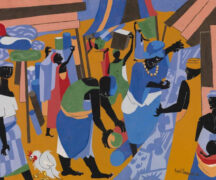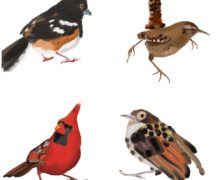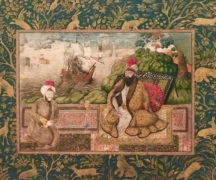By DAVID DUPONT
BG Independent News
Milt and Lee Hakel have poured their love of art into collecting art glass, and now they’re sharing a few favorite pieces with the world.
The Bowling Green couple have four pieces in the exhibit “Hot Spot: Contemporary Glass from Private Collections” now at the Toledo Museum of Art. The show is on exhibit in the Glass Pavilion through Sept. 18.
They are happy to have some of their glass treasures included, but Lee Hakel said her husband “was a little bereft when the pieces went off.”
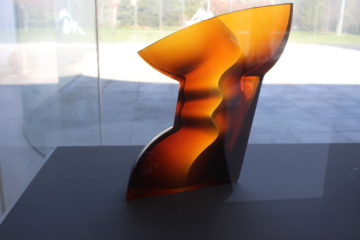
Figure by Latchezar Boyadjiev is one of the pieces on loan from the Hakel collection.
Not that the loans to the museum leave gaps in the Hakels’ home decor. The couple has been collecting glass for 20 years, and has no idea how many pieces they own. They are displayed throughout the house, from the sunroom to the bathroom. Milt Hakel said they are attracted to art glass because of its sculptural nature and because of the way glass interacts with light. “It’s so different in different lighting conditions.”
The vivid color is evident at every turn as a visitor moves through the house.
That’s what greeted Jutta-Annette Page, the museum’s curator for glass and decorative arts when she visited last fall. They got to know the curator through their involvement in the Glass Arts Society meeting in Toledo in 2012, marking the 50th anniversary of the glass arts movement.
“The Hakels are serious collectors,” she said.
She visited collectors within a 25-mile radius of the museum to find artwork that represents the current directions in art glass, both here and abroad. Of course, the Toledo area is just the right place to do that.
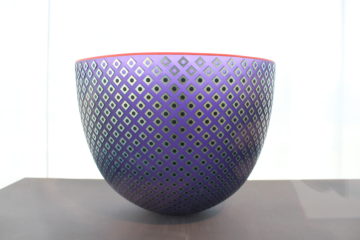
Hyacinth Bowl by Robert Wynne, from the collection of Milt and Lee Hakel, and now on display in “Hot Spot.”
The museum was central to the development in art glass. In 1962, potter Harvey Littleton, along with several colleagues, set up a studio to explore the use of glass in art. The efforts took place in the center of commercial and industrial glass production. Dominick Labino was an artist and glass craftsman who provided important insights.
Though not in the show, the Hakels own a relic of that time, a small bowl created by Labino that was given to Littleton.
After her visit, it took a while for Page to get back to the Hakels. They thought maybe she didn’t need anything from them.
That turned out not to be the case. Still, Lee Hakel said, “even if we didn’t have any pieces in the show it would still be exciting.” According to the museum most of the objects are on public view for the first time.
The Hakels know seen many of the collections represented in “Hot Spot.” But, she said, there are at least two collectors represented who they now want to visit.
The Hakels don’t have a particular focus to their collecting. In fact, they really didn’t set out to focus on glass. It just happened. It was 10 years ago when they purchased a piece by glass maestro Lino Tagliapietra that Milt Hakel finally said “we are collectors.”
Still these glass aficionados don’t just seek out the big names. They are just as interested in supporting up-and-coming artists, including students at BGSU. They point with pride at pieces from Ryan Thompson and Austin Littenberg.
They have helped establish The Labino Society to provide scholarships for BGSU students. Lee Hakel said they’d like to become patrons. “We’d like to know more about supporting the next generation.”
This is in keeping with their approach to collecting. They buy locally as well as when they travel. This has allowed them to collect on a budget. “We don’t have unlimited resources,” Lee Hakel said.
They remember back when they were first buying glass they came across a piece by Christopher Ries, an Ohio-born innovator. It was $300. A bargain, especially with the prices his work fetches now. But their son, Lane, needed new shoes, so they had to pass on it.
Page said finding work locally is not much of a restriction. Many of the artists who founded art glass stayed in the region, and traded pieces among themselves and sold to local buyers..
Lee Hakel said they’ve met many, if not most, of the artists represented in their collection.
“That’s one of the things about contemporary art glass, you can meet the artist,” Milt Hakel said.
The “Hot Spot” exhibit includes a range of work from the abstract to the whimsical. It is organized into seven thematic groups: the human figure, animals and plants, landscapes, vessel forms, the spirit world, abstract forms, and outer space.
Glass artists are always innovating. Many now study chemistry. The possibilities for how it can be fabricated are infinite, Lee Hakel said. As soon as the collectors start to feel they’ve learned all they can, they discovered a piece in which the glass naturally forms into lace-like shapes.
And then, Milt Hakel said, “it follows you home.”
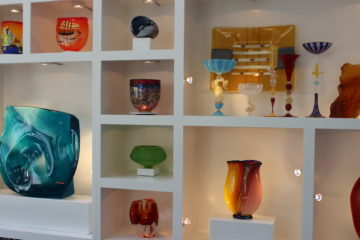
Art glass on display at Hakel home.


